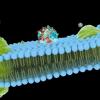
C60 in olive oil mediated life extension: Scientific discussions
#241
Posted 03 June 2012 - 08:16 PM
C60 decreases the production of proinflammatory cytokines in synovial inflammation-related cells
"TNF-α significantly stimulated the production of TNF-α (Figure 1A) and IL-1β (Figure 1B) by synovial fibroblasts, synovial infiltrating lymphocytes and infiltrating macrophages. In synovial fibroblasts, treatment with C60 (10.0 μM) significantly inhibited the TNF-α-induced excess production of TNF-α and IL-1β by the cells in synovial infiltrating lymphocytes and macrophages, C60 at 1.0 or 10.0 μM significantly suppressed the accelerated production of both proinflammatory cytokines, TNF-α and IL-1β, under catabolic stress, due to TNF-α at 10.0 ng /ml (Figures 1A, B). Our in vitro studies indicate that water-soluble C60 inhibits the following arthritis-related responses: the production of the proinflammatory cytokines, TNF-α and IL-1β from synovial fibroblasts, synovial infiltrating lymphocytes and macrophages. The results of our in vitro experiments suggest that C60 could have the potential to inhibit inflammatory synovitis in RA. The inhibitory effect of C60 on inflammation is based on the evidence that ROS is closely involved in the activation of inflammation-related cells. ROS is a messenger of the intracellular signal pathway for generation of inflammation.11–17 These results suggest that C60 might be used as an agent for suppressing proinflammatory cytokine production by infiltrating cells in RA synovial tissue and the resultant bone and joint destruction. It was suggested that C60 might be effective in the therapy and prevention of arthritis such as RA through suppression of inflammation by the cells involved."
http://www.ncbi.nlm....les/PMC2775692/
Well, I shall give it a go and report in the near future. Thank you all for the ALS related responses.
#242
Posted 03 June 2012 - 08:26 PM
#243
Posted 03 June 2012 - 09:53 PM
First, we don't know if the tripling of TNF found in rats given the C60(OH)20 solution also occurs in the C60/Olive Oil solution. Finding out whether it does or not would be a great and quick experiment to do. The rest of my comments assume that TNF is raised with the C60/Olive Oil potion as was the case in the C60(OH)20 solution.
niner... I agree with your reply that the study I referenced was about C60(OH)20 and not Olive Oil preparations... And I did precede all my remarks with the caveat above...
Let me explain my agenda that I haven't yet made clear... I volunteered to put significant time and energy into going after $ to fund Longecity sponsored research about this topic. And it makes me uncomfortable to think about doing that when our Explanations are one dimensional. THAT is why I'm throwing every objection I can think of, "left field" or not, so we can make sure we're defining the kinds of experiments to get at every question that needs getting at BEFORE we're in front of folks who might sponsor the research with $ contributions. We don't want to get caught flat footed having not thought about issues in the literature.
I'm not a scientist. I don't have the background or knowledge to evaluate many of these ideas. I have enormous respect for you and others. And I do have enough knowledge to attempt to throw hard and fast curve ball hypotheses at you, Turnbuckle, maxwatt, and others who are posting Explanations in this thread, curve balls which, hopefully, cause us to think harder about the issues.
Ok, so I've spilled it. That's my agenda. I understand it might be irritating but this curve ball I've thrown has accomplished something important. We now have to explain now why we might focus on C60s being a SOD memetic rather than focus on their role vis-a-vis TNF.
-----------
I think the hypothesis I laid out is still a valid one to test. There are other hypotheses to test. The evidence is contradictory with regard to TNF impact. TNF is also inhibited in some Fullerene studies, as others have pointed out. Both TNF and Superoxide play positive and negative roles in health and both are "deployed" by the immune system. That's why the evidence about them is contradictory. They're both involved in Host Defense and both involved in dangerous Auto-Immune overreaction.
Superoxide is biologically quite toxic and is deployed by the immune system to kill invading microorganisms.
- We don't know for certain that your hypothesis about some C60s being held persistently in cells is a valid one. And in case it's not, we need to have alternative hypotheses in our back pockets that have at least a minimum of credibility to them. I think the one I laid out does have that assuming there is the same kind of TNF spike I found a reference for with C60/Olive Oil.
- And we have a very difficult observation to explain: the virtually immediate "reset" that Turnbuckle experienced. You have strongly rejected Turnbuckle's explanation for a reset having taken place. So we better have a couple thoughts about how that might have happened... That hypothesis I laid out is another hypothesis.
So, IMHO, TNF and the Immune System are in this game of Explanation generation. And it's clear now that any serious Explanation needs to be Multi-Dimensional... IMO, that's what my throwing this curve ball has accomplished...
When we've walked through all this, we'll have as good an understanding of these issues, on multiple dimensions related to morbidity, mortality, and the possibilities of life extension as anyone else.
I'm sorry for being an irritant. But I feel like I have to be if I'm going to feel comfortable doing the job I volunteered to do...
Edited by wccaguy, 03 June 2012 - 10:08 PM.
#244
Posted 03 June 2012 - 09:54 PM
"Olive oil as a biocompatible solvent for pristine C60" claims that 0.8 mg/ml is completely impossible. It claims the upper limit is around 6 micrograms / ml, which is 133 times lower.
Who has made the error of two orders of magnitude?
Niners explanation makes sense.....
.9 g/L is the saturation limit for olive oil.
For actual dissolution without reaction. This would be the purple solution. Over time, or much more rapidly if heated, the C60 reacts with the fatty acid esters in the olive oil. This is the dark red solution, according to Cataldo. This forms at room temperature when exposed to oxygen over a period of two weeks. I suspect these adducts are the active species. My understanding is that you can get a lot more C60 into the oil if it's in the adduct form.
#245
Posted 04 June 2012 - 12:36 AM
Let me explain my agenda that I haven't yet made clear... I volunteered to put significant time and energy into going after $ to fund Longecity sponsored research about this topic. And it makes me uncomfortable to think about doing that when our Explanations are one dimensional.
I understand that oxidation reduction is achieved by calorie restriction. In pressing the case for multiple levels of Explanation including TNF I had these two studies and something like a dozen other studies, showing the same result, in mind.
Calorie restriction inhibits the age-related dysregulation of the cytokines TNF-α and IL-6 in C3B10RF1 mice
Small molecule activators of SIRT1 replicate signaling pathways triggered by calorie restriction in vivo
In the second study, paid for by Sirtris, the authors have an understandable and obvious incentive to make a case for their company's invention and product plans. Still, they go to very great lengths to demonstrate that they can account for the positive life span impacts of TNF reduction. See for yourself.
---------------
If we walk into potential funding contexts for the research we want to do with a presentation/proposal #1 based upon a narrow Single Dimension Explanation of Baati, I think we can get funding for the research projects we want to do.
But if we walk into those same opportunities with a presentation #2 about...
- the Extreme Longevity in Human studies related to Vagus/CAIP/HRV resulting in TNF reduction
- the Ext Longevity in Humans related to Positive Emotions and Vagus/CAIP/HRV, hence, TNF reduction
- the Ext Longevity in Humans related to Exercise and Vagus/CAIP/HRV, hence, TNF reduction
- the Ext Longevity in animals related to calorie restriction showing reduction in TNF
- and we show that Sirtris is clear they had to address the question of TNF while demonstrating the value of their potential products...
- the Fullerene studies showing life span extension
- the Fullerene studies showing TNF reduction
- and also... the Fullerene studies showing it to be a SOD memetic
- and more... anything you like... after all, it's multi-dimensional...
We then demonstrate the Longecity Community capability to...
- understand the importance of observation and the process of generating multiple Explanations that are hard to vary and Falsifiable through discussion and debate within its forum... (Potential funding sources are going to ask us "how is it legitimate to build Explanations around an n=1 anecdotal experience (i.e., Turnbuckle's.) Notice how that David Deutsch TED Talk perfectly sets up and legitimates our use of a trusted Community member's experience in generating Explanations...)
- define, in general and in detail, the multiple, Fullerene related study projects we want to do, in-vitro, short-term in-vivo, life span in-vivo studies... to address all the dimensions we think are important...
- provide these potential funding opportunities a chance to make a history making difference in lives...
Potential funding sources want to make a Positive difference. And when evaluating potential projects to fund, they have more reason to fund projects that demonstrate a higher probability of providing them with an opportunity to make a difference. We need to give them reasons to have more confidence is our projects and in our capabilities than in alternative projects they might fund.
In making Presentation 2 rather than Presentation 1, we are giving them more reasons to have confidence in us WITHOUT distorting any science... Am I wrong about that?
And now I've revealed more about what my agenda has been in pushing the issues I've pushed and creating the forum threads I've created... It's all part of an evil plan...
Edited by wccaguy, 04 June 2012 - 01:08 AM.
#246
Posted 04 June 2012 - 01:00 AM
[70] is an ellipsoid molecule, preferentially forming conjugates at its extremities - usually 4 chains will attach.The extra molecular mass of the C70 does not account for the discrepancy.
[60] is more symmetrical, and may possibly bond with fewer conjugates.
This may explain the difference in 'solubility'.
Remember, we are not strictly talking about solubility here, but reactivity......certainly the ruby red colour that gradually develops is the result of reaction products.
#247
Posted 04 June 2012 - 09:14 AM
Its already been proven that restricting access to food for mice (e.g. to 8 hours a day as in this study http://www.cell.com/...550413112001891) can increase lifespan by 40%, prevent liver disease and reduce inflammation.
Is there a chance that this is what was observed in the fullerene study? If the forum are conducting their own research I think there would be lots of value in repeating the study without starving the mice at all - though I know that produces difficulties in getting the mice to take the dose of fullerenes.
#248
Posted 04 June 2012 - 09:26 AM
http://www.owndoc.co...pan-of-mice.pdf
#249
Posted 04 June 2012 - 01:02 PM
I take it the mice were starved overnight in the original study.
Its already been proven that restricting access to food for mice (e.g. to 8 hours a day as in this study http://www.cell.com/...550413112001891) can increase lifespan by 40%, prevent liver disease and reduce inflammation.
Is there a chance that this is what was observed in the fullerene study? If the forum are conducting their own research I think there would be lots of value in repeating the study without starving the mice at all - though I know that produces difficulties in getting the mice to take the dose of fullerenes.
I cannot say that this isn't the case, but it would be unprofessional for a life-span study not to control for DR. I would think our astute members would have caught this were it so. Then too, it takes extreme caloric restriction to produce more than about 10% life extension, and the C60 mice showed much more than that.
Another angle - I am not a scientist, but this 2008 study appears to show a lifespan increase of 11% and improved brain function from dosage of some kind of Fullerene SOD Mimetic...
http://www.owndoc.co...pan-of-mice.pdf
Thanks for that study. It strengthens my suspicion that it is C60 adducts with olive oil polyphenols that are responsible for the effect we are seeing. If we are indeed seeing it, and if the study can be replicated, and if it works in other species....
The following is unmitigated cynicism but a fair and balanced objective viewpoint demands it be included: It's like the excitement over resveratrol, all over again. Hurry up and try some while it still works. Maybe Anthony can add resveratrol to the olive oil he is going to mix with C60 and form a resveratrol-C60 adduct many times more effective than resveratrol alone...
#250
Posted 04 June 2012 - 01:17 PM
Thanks so much for finding those articles on C60 and angiogenesis. I appreciate it. The information there is comforting.
wccaguy,
Thanks for your offer to look at the ALS article. Here is the link:
http://www.ncbi.nlm....les/PMC2776820/
Senso,
Nice find of that C60 can actually be anti-inflammatory.
It seems clear that the literature is contradictory on this point so I am just going to keep taking it (about 10 mg/day).
I am approaching one month of C60/OO 'treatment'. It is very difficult to judge changes in progression after only one month but if I was forced to give an evaluation I would say it has not affected my progression for better or worse. Improvements, even if slight are easier to detect but I have to say I have had none so far.
I would like to reiterate what Senso said, we don't want to hijack this thread and make it about ALS, and we introduce it into the discussion only as a hope of helping determine what the mechanism is by which it works (if it works) to help prolong lifespan. Moreover, if we do determine is slows the progression of ALS, that would be corroborating evidence that it can positively affect human lifespan. The advantage of testing this on ALS patients is that it is a human test, where the humans have a lifespan similar to rats, hence leading to results much faster than normal humans.
Thanks!!!
Ben
Edited by HappyPhysicist, 04 June 2012 - 01:21 PM.
#251
Posted 04 June 2012 - 03:23 PM
I take it the mice were starved overnight in the original study.
Its already been proven that restricting access to food for mice (e.g. to 8 hours a day as in this study http://www.cell.com/...550413112001891) can increase lifespan by 40%, prevent liver disease and reduce inflammation.
Is there a chance that this is what was observed in the fullerene study? If the forum are conducting their own research I think there would be lots of value in repeating the study without starving the mice at all - though I know that produces difficulties in getting the mice to take the dose of fullerenes.
Thanks for that link. Those animals were fed a high fat diet, so that throws a monkey wrench into the works. Did they see a 40% increase in lifespan? This might just mean that time-restricted feeding helps avoid steatosis and other problems caused by the un-natural diet. In Baati, the rats were on a normal rat diet, and the control and treatment groups had essentially identical body weights, which argues strongly against caloric restriction being at work. Also, Baati's rats only had 24 doses of olive oil/C60 over the course of their multi-year lives, so it's pretty hard to argue that diet alteration would play a large role.
My understanding of intermittent fasting using normal (rather than high fat) rodent diets is that most of the lifespan enhancement comes from inadvertent CR.
#252
Posted 04 June 2012 - 06:01 PM
Another angle - I am not a scientist, but this 2008 study appears to show a lifespan increase of 11% and improved brain function from dosage of some kind of Fullerene SOD Mimetic...
http://www.owndoc.co...pan-of-mice.pdf
Thanks for that study. It strengthens my suspicion that it is C60 adducts with olive oil polyphenols that are responsible for the effect we are seeing. If we are indeed seeing it, and if the study can be replicated, and if it works in other species....
How does that study strengthen your suspicion that olive oil polyphenols are interacting with C60? It didn't mention either olive oil or polyphenols...
There IS that unprecedented life extension reported for the olive oil-only rats. I could see where polyphenols had something to do with that, though I think it's even less likely to be real than the C60/oo arm.
#253
Posted 04 June 2012 - 06:15 PM
Remember there is a genetic link,as was posted earlier:You are right that extra calories are the "root" cause of the obesity epidemic, however, the take-off in pounds gained correlates very highly with the Ornish war on fat and increased high GI carb and sugar consumption beginning around 1980. If I was going too high on calories, I would much rather do it with olive oil, than carbs.
http://www.longecity...826#entry517826
The Paleo diet is not for everyone. Some people do quite well on Ornish type diets, as long as the carbs are not from fructose or sucrose, and are mostly complex carbs. If you are APOE5 this seems to be especially true.
About 30% of population will not gain weight if they get over 30% of their calories from saturated fats. Paleo diet is not for the rest. Another 30% or so will not gain weight from mono-unsaturated fats like Olive Oil. The remainder of us need to keep our caloric intake at under 30% fat of any kind or slowly get fat. Not necessarily an Ornish diet, but close.
#254
Posted 04 June 2012 - 09:00 PM
Getting back to olive oil and C60: just how much olive oil laced with C60 are we actually going to have to drink to see the effects seen in rodents., assuming their really is an effect?
At this point we can only speculate. First there's the question of reproducibility of the study- if someone else found that the olive oil-only arm was a lot closer to the water arm, and the C60 arm was displaced back at least that amount if not a lot more, that wouldn't surprise me at all. Then there's applicability to humans. As you move into longer-lived species, I'd expect better endogenous antioxidant protection, so there's not as much room for improvement. Instead of a 90% extension of lifespan, I'd be looking for a lot less.
Given all those caveats, the next question would be how much C60 do you actually need to see the effect, and what does the dose-response curve look like? If we manage to get a mouse study together, we should certainly look at dose response. At this point, I'd say the amount the rats got was 'enough'. At least for some amount of time. We don't know if they would have done even better if they were dosed again in later life. One could use the mg/kg dose the rats got as a starting point. If I were going to scale it, I think I would use the ratio of mitochondrial masses, and maybe something having to do with oxygen utilization as guide points. I would really be tempted to dose more frequently using smaller amounts each time. I'd also be interested in seeing if a more concentrated solution of the adduct could be made. Until we have more information, following the rat protocol means a week of grossness, drinking 4/5 of a cup of olive oil a day, then the remaining lower frequency dosing. It seems very likely to me that re-dosing periodically would have to help. I can see how a C60 fatty acid adduct could have a long residence time in a mitochondrial membrane, but not infinite. It also means starting at the human equivalent of ten months old in a Wistar Rat. How old is that? Somewhere in your early 20's?
I lol'ed at what you said about hurrying up and trying it before it stops working. If it works by slowing ROS damage, then there might be something to that.
#255
Posted 05 June 2012 - 12:25 PM
Abstract
Nano-scale particles have attracted a lot of attention for its potential use in medical studies, in particular for the diagnostic and therapeutic purposes. However, the toxicity and other side effects caused by the undesired interaction between nanoparticles and DNA/RNA are not clear. To address this problem, a model to evaluate the general rules governing how nanoparticles interact with DNA/RNA is demanded. Here by, use of an examination of 2254 native nucleotides with molecular dynamics simulation and thermodynamic analysis, we demonstrate how the DNA/RNA native structures are disrupted by the fullerene (C60) in a physiological condition. The nanoparticle was found to bind with the minor grooves of double-stranded DNA and trigger unwinding and disrupting of the DNA helix, which indicates C60 can potentially inhibit the DNA replication and induce potential side effects. In contrast to that of DNA, C60 only binds to the major grooves of RNA helix, which stabilizes the RNA structure or transforms the configuration from stretch to curl. This finding sheds new light on how C60 inhibits reverse transcription as HIV replicates. In addition, the binding of C60 stabilizes the structures of RNA riboswitch, indicating that C60 might regulate the gene expression. The binding energies of C60 with different genomic fragments varies in the range of -56 to -10 kcal mol(-1), which further verifies the role of nanoparticle in DNA/RNA damage. Our findings reveal a general mode by which C60 causes DNA/RNA damage or other toxic effects at a systematic level, suggesting it should be cautious to handle these nanomaterials in various medical applications.
Does anyone has access to the full study?
There's no mention of the methods employed here. But still, it may be of some interest for us.
#256
Posted 05 June 2012 - 12:35 PM
Fullerene, after it has reacted in olive oil, forms a new molecule.
Each new molecule - even cis and trans forms of the same molecule - have different chemical properties.
All those studies of water soluble fullerene are of limited importance here. As oil soluble fullerene was only developed around 2007, and fullerene in liposomes has only been used in a few studies, we should take care not to pay overly much attention to studies of pristine fullerene and water based fullerene.
Re the colour change: in one of his studies Cataldo remarks that the colour of the olive oil solution develops to a deep red over time, as (presumably) reactions take place with the fullerene.
Edited by Metrodorus, 05 June 2012 - 12:38 PM.
#257
Posted 05 June 2012 - 12:44 PM
#258
Posted 05 June 2012 - 01:18 PM
"Buckyballs enhance neurite outgrowth and double lifespan in mice[sic]"
#259
Posted 04 July 2012 - 05:32 AM
Looking at a 2x increase in life span, I have a hard time wrapping my mind around the fact that it has not spawned a small million trials, reproducing the effect, mining and extrapolating the results on varoius species.
Where is the outcry? The media? I mean reservatol made the headlines "redwine pill will save your life, children and mothers maiden name blablabla" .. but It is nowhere ... Why? It is just right here, a few chickens and a few brave souls.
I just dont get it.
Resveratrol came on the scene with a plausible "story", but not much in the way of results. There were results in things like yeast, but not in mammals. The "story" was wrong, but it sure sounded good- CR mimetic, French "paradox" explained; it was believable. Now we have an unbelievable result without a story. People don't believe unbelievable results. They love stories, but here we just have vague speculations.
#260
Posted 04 July 2012 - 08:58 AM
The mice in this study had nearly double lifespan extension on olive oil alone and then another 4 months (a small percentage more) with C60oo mixture.
This is an incorrect interpretation of the data.
Firstly, they were rats.....
18% increase in lifespan from olive oil alone
90% from oilive oil + fullerene,
as measured against the controls. (4.3 Baati et al)
There have been previous long term studies showing some increased life span effects, using different adducts of fullerene, including one notable study with mice.
However, each fullerene adduct is essentially a different molecule, so inferences are hard to draw in a meaningful, and consistent manner..
#261
Posted 05 July 2012 - 12:27 AM
18% increase in lifespan from olive oil alone.
This says a lot about olive oil.
http://www.longecity...tent-olive-oil/
#262
Posted 05 July 2012 - 11:50 AM
#263
Posted 07 July 2012 - 03:34 PM
The mice in this study had nearly double lifespan extension on olive oil alone and then another 4 months (a small percentage more) with C60oo mixture.
This is an incorrect interpretation of the data.
Firstly, they were rats.....
18% increase in lifespan from olive oil alone
90% from oilive oil + fullerene,
as measured against the controls. (4.3 Baati et al)
There have been previous long term studies showing some increased life span effects, using different adducts of fullerene, including one notable study with mice.
However, each fullerene adduct is essentially a different molecule, so inferences are hard to draw in a meaningful, and consistent manner..
Are you basing your interpretation on the original charts in the paper? The original charts contained errors. AgeVivo re-analyzed the data, perhaps he can clarify the corrected lifespan.
#264
Posted 07 July 2012 - 03:51 PM
The mice in this study had nearly double lifespan extension on olive oil alone and then another 4 months (a small percentage more) with C60oo mixture.
This is an incorrect interpretation of the data.
Firstly, they were rats.....
18% increase in lifespan from olive oil alone
90% from oilive oil + fullerene,
as measured against the controls. (4.3 Baati et al)
There have been previous long term studies showing some increased life span effects, using different adducts of fullerene, including one notable study with mice.
However, each fullerene adduct is essentially a different molecule, so inferences are hard to draw in a meaningful, and consistent manner..
Are you basing your interpretation on the original charts in the paper? The original charts contained errors. AgeVivo re-analyzed the data, perhaps he can clarify the corrected lifespan.
Here's a new twist: make the original paper free, but make people pay for the corrections--
Corrigendum to “The prolongation of the lifespan of rats by repeated oral administration of [60]fullerene”
#265
Posted 07 July 2012 - 04:51 PM
Edited by JohnD60, 07 July 2012 - 04:58 PM.
#266
Posted 08 July 2012 - 03:19 AM
Here's a new twist: make the original paper free, but make people pay for the corrections--
Corrigendum to “The prolongation of the lifespan of rats by repeated oral administration of [60]fullerene”
Well, the first paper wasn't really free AFAIK; it 'found its way' onto the net... However, $38 for errata is egregious. BUT... if you look closely at the thumbnails they provide for the images, you can see that Baati et al. have changed the x axis of the mortality curve to match the text in the paper, which is what AgeVivo told us a couple weeks ago. They also fixed the messed up histology slides.
#267
Posted 08 July 2012 - 07:13 PM
Yes: the corrigendum essentially contains the 3 graphs that are shown on that link:, of which only the first one is important to us: the corrected lifespan curves indicating that the oldest rats was 54 month old at time of deathHere's a new twist: make the original paper free, but make people pay for the corrections--
Corrigendum to “The prolongation of the lifespan of rats by repeated oral administration of [60]fullerene”
Well, the first paper wasn't really free AFAIK; it 'found its way' onto the net... However, $38 for errata is egregious. BUT... if you look closely at the thumbnails they provide for the images, you can see that Baati et al. have changed the x axis of the mortality curve to match the text in the paper, which is what AgeVivo told us a couple weeks ago. They also fixed the messed up histology slides.
Edited by AgeVivo, 08 July 2012 - 07:14 PM.
#268
Posted 08 July 2012 - 08:49 PM
The most important sentence, as far as this thread is concerned,is that the review panel accepted that the errors in the graph and the histology slide made no material difference to the conclusion reached.
"Due consideration has been given to the potential effect of these errors on the overall results and conclusions drawn, and so it has been decided the conclusions are still valid. The authors have provided explanations of how the errors were made during the preparation of graphics and images."
Looking at the original survival graph, the source of error is immediate - the connecting lines between the data points after each death should have been vertical, but they were sloped, adding extra weeks to the overall duration of the study. The relative positions of the data points to one another was not, however, affected by this error.
All the fullerene OO rats were still alive after all the other rats were dead, irrespective of the graph you look at. What is striking about this study, is the uniformity of survival of the fullerene OO cohort, that striking horizontal line at the top of the graph.
http://retractionwat...lems/#more-8407

Edited by Metrodorus, 08 July 2012 - 09:29 PM.
#269
Posted 08 July 2012 - 10:13 PM
#270
Posted 08 July 2012 - 10:38 PM
That one Olive Oil only rat sure sticks out - the one that lived 50 months. Perhaps an error or cross contamination of food?
Actually I wasn't going to say it but I speculated the same....looks suspiciously like it might have somehow got a dose of the C60 either by mistake or contamination.
Also tagged with one or more of these keywords: c60, buckyballs, lifespan, baati, moussa, fullerenes
2 user(s) are reading this topic
0 members, 2 guests, 0 anonymous users






























 This topic is locked
This topic is locked






















